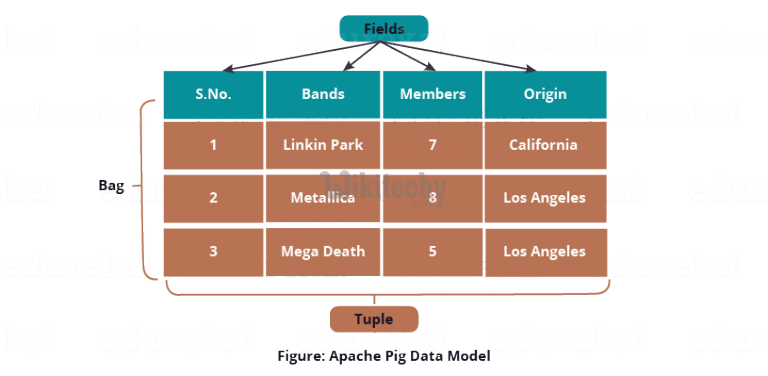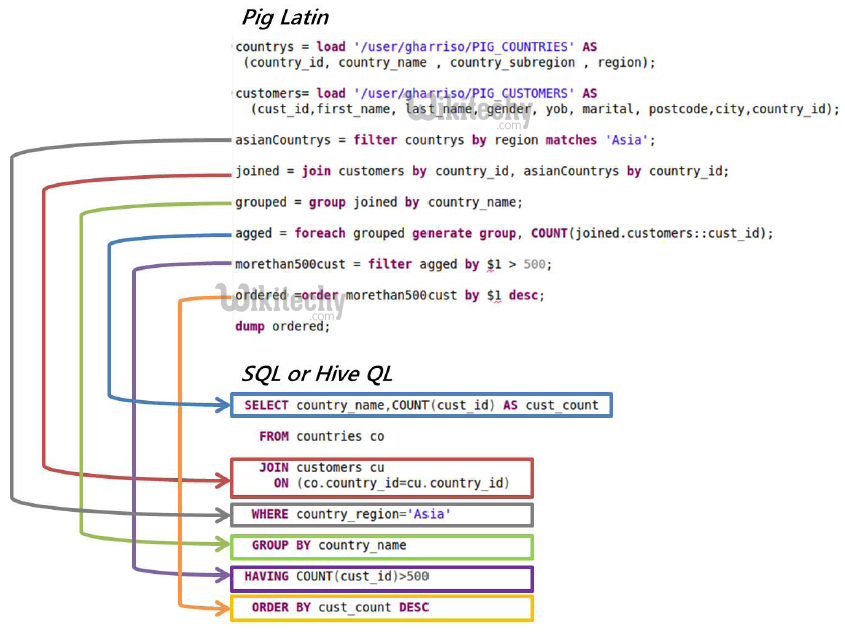pig tutorial - apache pig tutorial - Apache Pig Latin - Basics - pig latin - apache pig - pig hadoop
What is Pig Latin?
- The Pig Latin basics are given as Pig Latin Statements, data types, general and relational operators, and Pig Latin UDF’s.
- Pig Latin is the language which is used to analyze data in Hadoop by using Apache Pig.
- Pig Latin is a dataflow language where each processing step will result in a new data set, or in a relation.
Pig Latin - Data Model
- The data model of Pig Latin is fully nested. The Relation in Pig Latin is the structure of the Pig Latin data model. And it has a bag where −
- A bag has a collection of tuples.
- A tuple is an ordered set of fields which is given.
- A field is the piece of data.

Learn apache pig - apache pig tutorial - Apache Pig Latin Basics - apache pig examples - apache pig programs
Pig Latin - Statements
Pig Latin vs hiveql

- The data model of Pig Latin is fully nested.
- The Relation in Pig Latin is the structure of the Pig Latin data model. And it has a bag where −
- Pig Latin Statements are the basic statements while processing the data by using Pig Latin.
- The statements work with relations used in Pig Latin and they include the expressions and schemas.
- The every statement which is given in Pig Latin will end with a semicolon (;).
- We can perform various operations by using operators which is provided by Pig Latin done through statements.
- Pig Latin statements take a relation as input and produce another relation as output except for Load and Store while performing the other operations in Pig Latin
- When we enter a Load statement in the Grunt shell, the semantic checking for Load store will be carried out.
- If we need to see the contents of the schema, we can use the Dump operator.
- The MapReduce job is done for loading the data which is done into the file system will be carried out only after performing the dump operation which is done in Pig Latin.
Example
grunt> Employee_data = LOAD 'wikitechy_employee_data.txt' USING PigStorage(',')as
( id:int, firstname:chararray, lastname:chararray, phone:chararray, city:chararray );
Pig Latin - Data types
- The table which is given below describes the Pig Latin data types.
Simple Types
| Operator | Description | Example |
|---|---|---|
| int | Signed 32-bit integer | 10 |
| long | Signed 64-bit integer | Data: 10L or 10l Display: 10L |
| float | 32-bit floating point | Data: 10.5F or 10.5f or 10.5e2f or 10.5E2F Display: 10.5F or 1050.0F |
| double | 64-bit floating point | Data: 10.5 or 10.5e2 or 10.5E2 Display: 10.5 or 1050.0 |
| chararray | Character array (string) in Unicode UTF-8 format | hello world |
| bytearray | Byte array (blob) | |
| boolean | boolean | true/false (case insensitive) |
Complex Types
| Operator | Description | Example |
|---|---|---|
| tuple | An ordered set of fields. | (19,2) |
| bag | An collection of tuples. | {(19,2), (18,1)} |
| map | A set of key value pairs. | [name#John,phone#5551212] |
Null Values
- The values for all the above data types which is given in a table can be NULL.
- Pig Latin treats null values in a same way as Apache Pig and SQL
- The null value which is given can be a non-existent value.
- The null value is used as a placeholder for optional values.
- The null value can be given as the result of an operation.
Pig Latin - Arithmetic Operators
- The table which is given below describes the arithmetic operators of Pig Latin. For example consider a = 10 and b = 20.
| Operator | Description | Example |
|---|---|---|
| + | Addition − Adds values on either side of the operator | a + b will give 30 |
| − | Subtraction − Subtracts right hand operand from left hand operand | a − b will give −10 |
| * | Multiplication − Multiplies values on either side of the operator | a * b will give 200 |
| / | Division − Divides left hand operand by right hand operand | b / a will give 2 |
| % | Modulus − Divides left hand operand by right hand operand and returns remainder |
b % a will give 0 |
| ? : | Bincond − Evaluates the Boolean operators. It has three operands as shown below. variable x = (expression) ? value1 if true : value2 if false. |
b = (a == 1)? 20: 30; if a = 1 the value of b is 20. if a!=1 the value of b is 30. |
CASE WHEN THEN ELSE END |
Case − The case operator is equivalent to nested bincond operator. | CASE f2 % 2
WHEN 0 THEN 'even' WHEN 1 THEN 'odd' END |
Pig Latin – Comparison Operators
The following table describes the comparison operators of Pig Latin.
| Operator | Description | Example |
|---|---|---|
| == | Equal − Checks if the values of two operands are equal or not; |
(a = b) is not true |
| != | Not Equal − Checks if the values of two operands are equal or not. |
(a != b) is true. |
| > | Greater than − Checks if the value of the left operand is greater than |
(a > b) is not true. |
| < | Less than − Checks if the value of the left operand is less than the |
(a < b) is true. |
| >= | Greater than or equal to − Checks if the value of the left operand is |
(a >= b) is not true. |
| <= | Less than or equal to − Checks if the value of the left operand is |
(a <= b) is true. |
| matches | Pattern matching − Checks whether the string in the left-hand side |
f1 matches '.*tutorial.*' |
Pig Latin - Type Construction Operators
- The table which is given below describes the Type construction operators of Pig Latin.
| Operator | Description | Example |
|---|---|---|
| () | Tuple constructor operator − This operator is used to construct a tuple. |
(Raju, 30) |
| {} | Bag constructor operator − This operator is used to construct a bag. |
{(Raju, 30), (Mohammad, 45)} |
| [] | Map constructor operator − This operator is used to construct a tuple. |
[name#Raja, age#30] |
Pig Latin - Relational Operations
- The table which is given below describes the relational operators of Pig Latin.
| Operator | Description |
|---|---|
| Loading and Storing | |
| LOAD | To Load the data from the file system (local/HDFS) into a relation. |
| STORE | To save a relation to the file system (local/HDFS). |
| Filtering | |
| FILTER | To remove unwanted rows from a relation. |
| DISTINCT | To remove duplicate rows from a relation. |
| FOREACH, GENERATE | To generate data transformations based on columns of data. |
| STREAM | To transform a relation using an external program. |
| Grouping and Joining | |
| JOIN | To join two or more relations. |
| COGROUP | To group the data in two or more relations. |
| GROUP | To group the data in a single relation. |
| CROSS | To create the cross product of two or more relations. |
| Sorting | |
| ORDER | To arrange a relation in a sorted order based on one or more fields (ascending or descending). |
| LIMIT | To get a limited number of tuples from a relation. |
| Combining and Splitting | |
| UNION | To combine two or more relations into a single relation. |
| SPLIT | To split a single relation into two or more relations. |
| Diagnostic Operators | |
| DUMP | To print the contents of a relation on the console. |
| DESCRIBE | To describe the schema of a relation. |
| EXPLAIN | To view the logical, physical, or MapReduce execution plans to compute a relation. |
| ILLUSTRATE | To view the step-by-step execution of a series of statements. |
